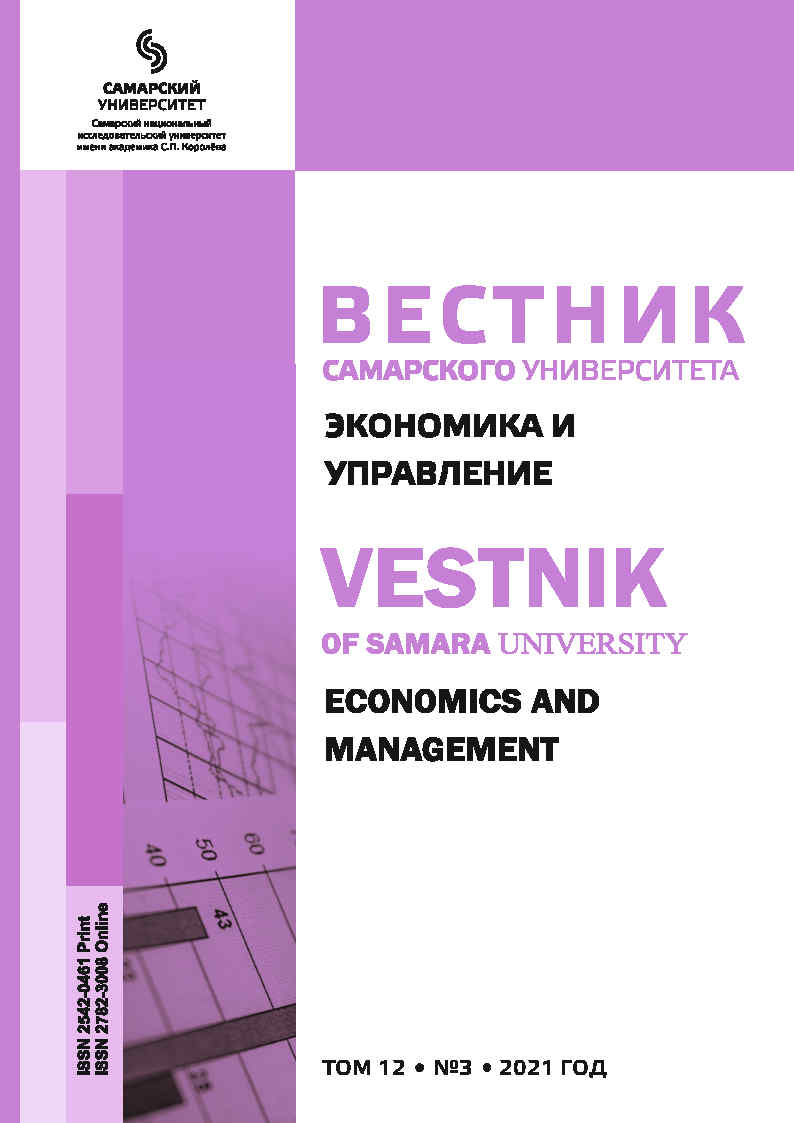Методология формирования латентных индикаторов
- Авторы: Трусова А.Ю.1, Ильина А.И.1
-
Учреждения:
- Самарский национальный исследовательский университет имени академика С.П. Королева
- Выпуск: Том 12, № 3 (2021)
- Страницы: 179-191
- Раздел: МАТЕМАТИЧЕСКИЕ И ИНСТРУМЕНТАЛЬНЫЕ МЕТОДЫ ЭКОНОМИКИ
- URL: https://journals.ssau.ru/eco/article/view/9876
- DOI: https://doi.org/10.18287/2542-0461-2021-12-3-179-191
- ID: 9876
Цитировать
Полный текст
Аннотация
Пищевая промышленность выступает важнейшим звеном продовольственного комплекса государства, определяя возможность его автономного существования в критических ситуациях. Данный вид промышленности играет ведущую роль в решении вопроса обеспечения населения продуктами питания в достаточном ассортименте и объемах. Пищевая отрасль востребована во всем мире, так как потребность в пище является базовой потребностью каждого человека. Уникальность пищевой промышленности России определяется тесной привязкой к региональным особенностям и, как следствие, неравномерностью размещения предприятий пищевой промышленности по территории страны. Исследование посвящено изучению взаимосвязей показателей пищевой промышленности с показателями социально-экономической сферы и формированию латентных индикаторов экономики по показателям развития пищевой промышленности на примере Приволжского федерального округа. В работе проведено многомерное изучение тесноты взаимосвязи показателей пищевой промышленности с показателями социально- экономической сферы средствами канонического анализа. Наибольшую связь показатели пищевой промышленности имеют с показателями здоровья населения, так как значимый коэффициент канонической корреляции в 2019 году составил более 0,6. В этой группе показателей анализ канонической корреляции позволил выявить, что набольшее влияние оказывают такие показатели, как производство скота и птицы на убой, а также валовой сбор овощей. Коэффициенты при показателях общих коэффициентов рождаемости и смертности очень высокие в этих изучаемых группах. Это свидетельствует о том, что ухудшения в качестве и количестве производимой продукции, приведут к снижению рождаемости и росту уровня смертности. В работе на основе канонических переменных проведена визуализация многомерных данных и предложен способ классификации субъектов в пространстве ресурсов и потенциала. Результаты кластеризации в пространстве растительных ресурсов и торгового потенциала показывает нам, какие субъекты, имеющие близкое расположение в данном пространстве, могут обмениваться технологическим опытом и оказывать поддержку друг другу. В работе также проведено ранжирование субъектов Приволжского федерального округа с учетом степени воздействия показателей пищевой сферы в пространстве латентных индикаторов.
Ключевые слова
Об авторах
Алла Юрьевна Трусова
Самарский национальный исследовательский университет имени академика С.П. Королева
Автор, ответственный за переписку.
Email: a_yu_ssu@mail.ru
ORCID iD: 0000-0001-7679-9902
кандидат физико-математических наук, доцент кафедры «Математика и бизнес- информатика»
Россия, г. Самара, Московское шоссе, 34.Алла Ивановна Ильина
Самарский национальный исследовательский университет имени академика С.П. Королева
Email: iai.62@mail.ru
ORCID iD: 0000-0002-7624-5771
старший преподаватель кафедры «Математика и бизнес-информатика»
Россия, г. Самара, Московское шоссе, 34.Список литературы
- 1.Проект Стратегии развития пищевой и перерабатывающей промышленности Российской Федерации на период до 2030 года [Электронный ресурс] // Министерство сельского хозяйства Российской Федерации. URL: https://barley-malt.ru/wp-content/uploads/2019/11/proekt-strategyy-razvytyja-pyschevoj-y-pererabatyvajuschej- promyshlennosty-rf.pdf.
- 2.Бондарева С.А. Внедрение системы прослеживаемости пищевых продуктов в условиях цифровой экономики [Текст] // Сборник статей Международной научно-практической конференции «Новые подходы к разработке технологий производства и переработки сельскохозяйственной продукции». 2018. С. 412–417.
- 3.Батталова А.Р. Продовольственная безопасность в регионах Приволжского Федерального округа // Известия Санкт-Петербургского государственного аграрного университета, 2016. № 44. C. 188–195. URL: https://elibrary.ru/item.asp?id=27674943.
- 4.Садекова Н.Х. Развитие пищевой промышленности России в условиях импортозамещения // Продовольственная политика и безопасность. 2016. Т. 3, № 2. С. 77–90. URL: http://doi.org/10.18334/ppib.3.2.35798.
- 5.Ялунина Е.Н. Повышение эффективности развития пищевой промышленности в России с помощью инструментов стратегического управления [Текст] / Е.Н Ялунина, В.М. Гаянова // Российское предпринимательство. 2014. № 17 (263). С. 120–133. URL: https://elibrary.ru/item.asp?id=21981483.
- 6.Хабазина Л.Н. Развитие пищевой промышленности в составе агропромышленного комплекса региона [Текст] / Л.Н. Хабазина, Н.П. Зыряева // Вестник российского университета кооперации. 2016. № 2 (24). С. 70–73. URL: https://elibrary.ru/item.asp?id=26561151.
- 7.Кузьмина А.О. Современное состояние и тенденции развития пищевой промышленности России [Текст]
- // Молодой ученый. 2019. № 17 (255). С. 149–152. URL: https://elibrary.ru/item.asp?id=37527686.
- Орлова И.В. Многомерный статистический анализ при исследовании экономических процессов [Текст] / И.В. Орлова, В.Б. Турундаевский // Международный журнал экспериментального образования. 2015. № 5-
- 2. С. 263–264. URL: https://elibrary.ru/item.asp?id=23379095.
- 8.Гаврилец Ю.Н. Статистический анализ факторов социальной напряженности в России [Текст] / Ю.Н. Гаврилец, К.В. Клименко, А.В. Кудров // Экономика и математические методы. 2016. № 52 (1). С. 45–66. URL: http://www.cemi.rssi.ru/emm/files/2016-01-Gavriletc.pdf; https://elibrary.ru/item.asp?id=25908874.
- 9.Боуш Г.Д. Агентное моделирование процессов кластерообразования в региональных экономических системах [Текст] / Г.Д. Боуш, О.М. Куликова // Экономика региона. 2016. Т. 12, Вып. 1. С. 64–77. DOI: http://doi.org/10.17059/2016-1-5.
- 10.Тихомиров Н.П. Методы эконометрики и многомерного статистического анализа [Текст] / Н. П. Тихомиров, Тихомирова Т.М., Ушмаев О.С. – Москва: Экономика, 2017. 989 c. URL: https://elibrary.ru/item.asp?id=26761323.
- Кузьмина А.О., Жерноклеева А.С. Современное состояние и тенденции развития пищевой промышленности / А. О. Кузьмина, А. С. Жерноклеева // Молодой ученый. 2019. № 17 (255). С. 149–152. URL: https://moluch.ru/archive/255/58540/; https://elibrary.ru/item.asp?id=37527686.
- 11.Пранов, Б.М. Моделирование экономико-управленческих аспектов устойчивого развития на региональном уровне посредством многомерного статистического анализа [Текст] / Б.М. Пранов, Т.В. Рассохина, И.А. Ронжина. Москва: Издательский дом «Дело» РАНХиГС, 2019. 190 с. URL: https://elibrary.ru/item.asp?id=41269920.
- 12.Регионы России. Социально-экономические показатели. 2020 г. [Электронный ресурс] // Федеральная служба государственной статистики. URL: https://rosstat.gov.ru/folder/210/document/13204.
- 13.Инвестиции в основной капитал по видам экономической деятельности по субъектам Российской Федерации: [Электронный ресурс] // Федеральная служба государственной статистики. URL: https://rosstat.gov.ru/storage/mediabank/invest_sub.xlsx.
- 14.Локосов В.В., Рюмина Е.В., Ульянов В.В. Макрорегионы России: характеристика человеческого потенциала. // Народонаселение. 2018. Т. 21. № 3. С. 37–51. doi: 10.26653/1561-7785-2018-21-3-03.
- 15.Улумбекова Г.Э., Прохоренко Н.Ф., Калашникова А.В., Гиноян А.Б. Системный подход к достижению общенациональной цели по увеличению ожидаемой продолжительности жизни до 78 лет к 2024 году. // Экономика. Налоги. Право. 2019. Том 12, № 2. С. 19–30. DOI: https://doi.org/10.26794/1999-849X-2019-12- 2-19-30.
Дополнительные файлы










